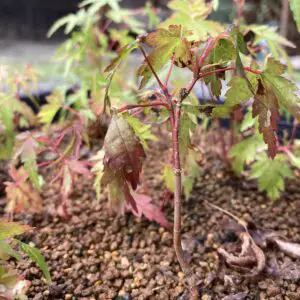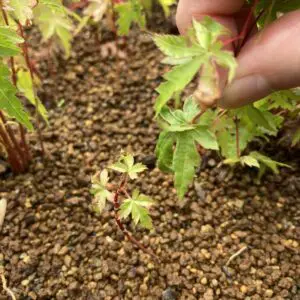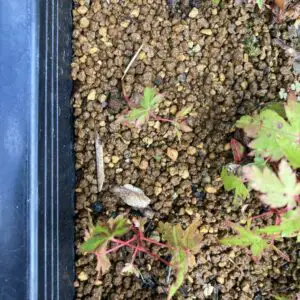You need 30 seeds to make a bonsai tree in 5 years from germination. Seeds’ germination and survival rate as well as seedlings’ potential for growing into a good bonsai tree are the factors affecting the number of seeds necessary.
How many seeds do you need to grow a bonsai tree?
How many seeds you need to grow a bonsai tree depends on 3 factors;
- seed germination rate,
- seedling survival rate, and
- seedlings’ potential for growing into a good bonsai tree.
Theoretically, you need 30 seeds to grow 1-2 bonsai trees in 5 years. This is based on;
- good seed germination rate of 80% (24/30 seeds germinate),
- seedling survival rate of 80% (20/24 seedlings survive in a year), and
- seedlings’ potential for growing into a good bonsai tree after 1 year of 50% (10/20 seedlings are good for bonsai training).
Let me explain in detail.
Germination rate
What is germination rate?
Germination rate is the number of seeds sprouted out of the total seeds sown, multiplied by 100. This is important because not all seeds you sow will germinate.
What affects germination rate?
Germination rate may be affected by the following conditions.
- Plants’ ability to produce viable seeds
- Infestation/diseases
- Environmental conditions
- Age of seeds
- Storage
All fully developed seeds contain an embryo that enables them to germinate. But sometimes, plants produce seeds that lack embryos and those seeds will never germinate. Predators like insects and birds feed on seeds and too much moisture in soil may induce fungi growth. Too much rain can wash away seeds. All of these prohibit the seeds to germinate.
The age of the seed also affects the germination ability. Seeds are living embryos. Over time, their cells die and those cannot be replaced. The amount of time a seed remains viable can be influenced by both genetics and the environment. Some seeds can remain viable under optimal conditions for many years, and others for only a season cycle.
Seeds thus have a kind of expiration date, after which the seed viability drops off markedly.
Incorrect or inadequate storage is another cause that affects the germination rate. In fact, seed storage is very important to secure good quality seeds. The most important factors influencing storage are temperature, moisture, seed characteristics, micro-organism, geographical location and storage structure.
Seed viability can be extended by cold or dry storage at seed moisture content below 5%. But if the seeds are not stored appropriately at stores or at home, their viability drops.
Seeds with good germination rate
Obviously, the higher the germination the better but not all the seeds will germinate as seen above. Anything above 80% is considered a good seed germination rate. At the good germination rate of 80%, 24 out of 30 seeds will be seedlings.
Seedling survival rate
What is seedling survival rate?
Seedling survival rate is the number of surviving plants out of total seeds sown, multiplied by 100.
What affects the survival rate?
Seedling survival rate may be affected by the following conditions.
- Seed size
- Seedling care
- Climate conditions
Seed size is commonly related to higher rates of seedling survival. Larger seed size provides survival advantages beyond germination up until the reproduction phase. Larger seed size also provides a bet-hedging strategy in temporally unpredictable environments.
Seedlings’ survival rate depends, of course, on how you care for them. Drought and moisture stress from inadequate watering, lack of fertilizing, as well as maltreating infestation/disease, can all negatively affect the survival of the seedlings.
Climate conditions such as prolonged days of high/low temperature, rainfall or sunny days can also kill them.
Study on the seedlings survival rate
According to this study, only 4 out of 5 seedlings that have successfully germinated would survive the first year.
The study shows that the average survival rate of 5 tree species, namely Norway spruce, Scots pine, European larch, European beech and Sycamore maple, after the first winter season and the first growing season is 81%.
Researchers planted a total of 4,500 seedlings in containers and nursery beds, with or without fertilizers, to see the effect of planting time (fall and spring) and application of the commercial fertilizer on the survival, damage and growth of the above forest tree species.
Survival of seedlings after the first winter season and the first growing season
| Tree species | Survival rate (%) |
| Norway spruce | 70 |
| Scots pine | 86 |
| European Larch | 76 |
| European Beech | 80 |
| Sycamore maple | 84 |
| Average | 81 |
(Souce: Table 2 in Repáč, I. & Tučeková, A. & Sarvašová, Ivana & Vencurik, Jaroslav. (2018). Survival and growth of outplanted seedlingsof selected tree species on the High Tatra Mts. windthrow area after the first growing season. Journal of Forest Science. 57. 349-358.)
Except for Norway spruce, whose survival rate is higher in nursery beds, those planted in a container pulled through at a higher rate. The effect of commercial fertilizer for containerized seedlings is only positive for Norway spruce. For other tree species, it actually had a negative effect on the tree’s survival.
Seedlings’ potential for growing into a good bonsai tree
Almost any tree species can be a bonsai tree but seedlings with the following characteristics will make the best bonsai.
- Tiny leaves
- Abundant foliage
- Good ramification (fine branches)
- Short internodes
- Beautiful tree bark
Furthermore, certain bonsai style requires certain features in the seedlings to be good bonsai in that style.
For example, good candidate for formal upright style (Chokkan) are;
- good Nebari ((surface) roots that spread evenly in every direction),
- straight Tachiagari (the lowest part of the trunk to the first branch from the bottom grows straight),
- upright trunk,
- short internodes,
- branches ramify finely and grow closely together, and
- branches grow alternately around the trunk from left to right and from front to back.
For more detail on how to shape a baby bonsai, please read the following post.
My (little) study
Out of 21 Japanese maple seedlings (excluding those for forest style), 7 months from germination, only 5 have good potential for growing into good bonsai trees. Another 5 may be OK.
The remaining 11 seedlings either have no bonsai potential or may not survive the first winter.
This means only half of the seedlings that are still growing after 7 months of germination can start bonsai training. Considering those good half may die naturally in the coming years or from wrong caring/mistreatment, I believe only 1 or 2 out of 21 seedlings will survive in 5 years and become bonsai trees. For a beginner, it might be at a lower rate.
—–
Reference
Repáč, I. & Tučeková, A. & Sarvašová, Ivana & Vencurik, Jaroslav. (2018). Survival and growth of outplanted seedlingsof selected tree species on the High Tatra Mts. windthrow area after the first growing season. Journal of Forest Science. 57. 349-358.
Shaban, M. (2013). ‘Study on some aspects of seed viability and vigor‘, International Journal of Advanced Biological and Biomedical Research, 1(12), pp. 1692-1697.










